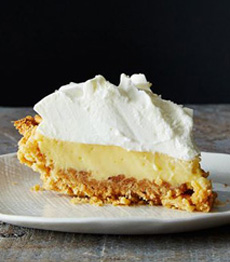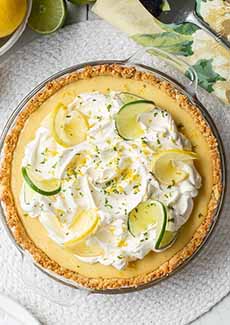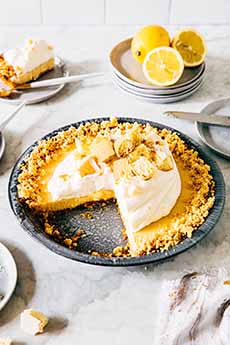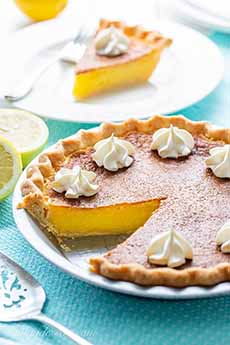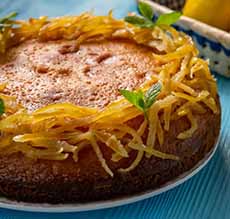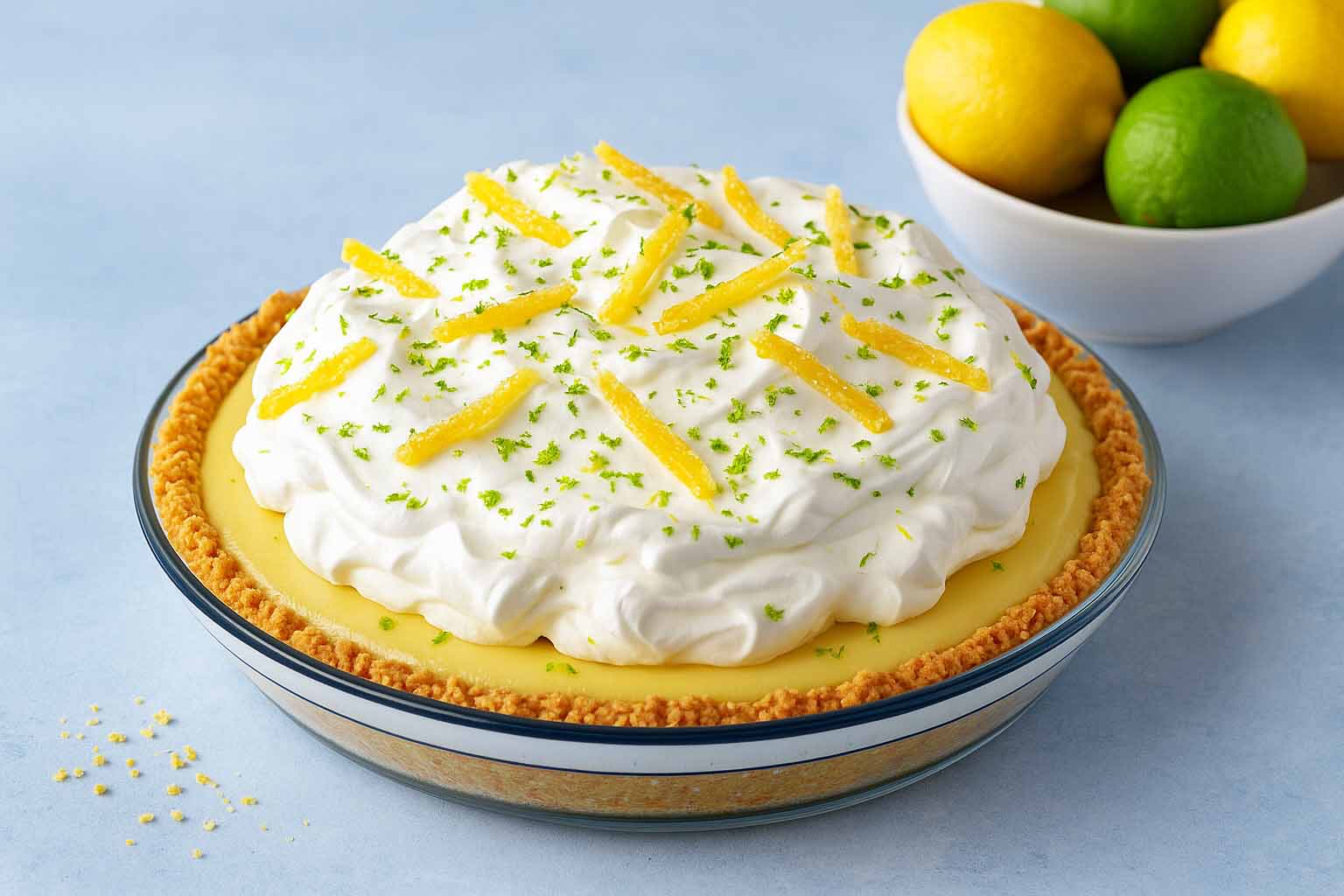RECIPE: Atlantic Beach Pie, A Spin On Lemon Meringue Pie
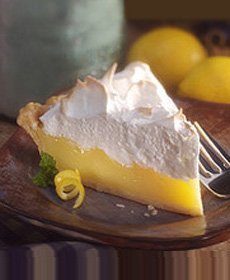 [1] A slice of classic lemon meringue pie. Here’s the recipe (photo © IncredibleEgg.org).
|
August 15th is National Lemon Meringue Pie Day, celebrating one of America’s favorite pies. We’re celebrating with an Atlantic Beach Pie, a variation that originated at the Atlantic shore of North Carolina. > The recipe follows the history of Atlantic Beach pie. > The different types of pie: a photo glossary. > The difference between pies and tarts. > The different types of lemons: a photo glossary. Lemon-flavored custards, puddings and pies date to the Middle Ages, which concluded in the 15th century. Meringue was perfected in the 17th century. The modern lemon meringue pie, which inspired the 21st-century Atlantic Beach pie, is a 19th-century recipe, attributed to Alexander Frehse, a baker in the Swiss canton of Romandie. By the late 19th century, the dish had reached the U.S. and achieved popularity. It combines a lemon custard single crust pie with meringue, the fluffy topping made from egg whites and sugar, baked on top. Here’s the classic lemon meringue pie recipe. Fast-forward a century to Atlantic Beach Lemon Pie, a Southern specialty from the beaches of North Carolina. Like the lemon meringue pie, the Atlantic Beach pie has a lemon curd filling. But instead of the traditional pie crust (usually a flaky crust but some recipes use a shortbread or a graham cracker crust), the Atlantic Beach pie uses something evocative of the salty ocean: crushed saltine crackers (some recipes use Ritz Crackers). Instead of the meringue top, Atlantic Beach pie has whipped cream sprinkled with coarse salt. The recipe was developed by Bill Smith, then chef at Chapel Hill, North Carolina. As a child in the 1950s and 1960s, Bill, who grew up near the North Carolina coast, had vacationed in Atlantic Beach, North Carolina, where local tradition was that only citrus-based desserts could be safely eaten after eating seafood. In fact, some coastal seafood restaurants offered lemon meringue pie as their only dessert. Bill became a chef, and was working at Crook’s Corner in Chapel Hill, North Carolina when asked to develop a dessert for a 2011 Southern Foodways Alliance. He developed a pie inspired by the lemon meringue pies of North Carolina’s seafood restaurants, changing the crust and the topping. Chef Bill added his own touch, substituting whipped cream for the meringue topping. Chef Bill has been generous with his recipe. We encountered this recipe in OurState, magazine in Greensboro, North Carolina, whose editor asked him to write about it. Here’s the original article. A bit of biography: Bill was recognized by the James Beard Awards as a finalist for Best Chef Southeast in 2009 and 2010. He retired from Crook’s Corner in 2019 after almost 30 years, to focus on writing and other food-related activities. Here’s more about him. The restaurant closed in 2021, a victim of the Pandemic. Some recipe authors refer to Atlantic Beach pie as “like Key lime pie.” It isn’t. While both pies have a citrus-based filling made with eggs, Key lime pie typically uses sweetened condensed milk. The latter creates a creamier filling. Ingredients For The Crust 1. PREHEAT the oven to 350°F. Place the crackers in a plastic bag, seal and crush crush with a rolling pin into tiny, flaky pieces. You will have about 2½ to 3 cups of cracker crumbs. Do not use a food processor or you will end up with cracker dust that doesn’t work. 2. ADD the sugar, then knead in the butter until the crumbs hold together like dough. Press into an 8-inch pie pan. Chill for 15 minutes, then bake for 18 minutes or until the crust colors a little. While the crust is cooling… 3. BEAT the egg yolks into the milk, then beat in the citrus juice. It is important to completely combine these ingredients. 5. POUR into the shell and bake for 16 minutes until the filling has set. The pie needs to be completely cold to be sliced. Serve with fresh whipped cream and a sprinkling of sea salt. |
|
|
THE HISTORY OF PIE The ancient Egyptians, who were great bread bakers, worked out the details of early pastry. Theirs was a savory pastry: a dough of flour and water paste to wrap around meat and soak up the juices as it cooked. Before the creation of baking pans in the 19th century, the coffin (from the French word for box), a very thick crust, was used to bake all food. It was inedible, not like the later “en croute” dishes. Its primary function was to protect and seal the food during cooking and storage†. Pastry was further developed in the Middle East and brought to Mediterranean Europe by the Muslims in the 7th century. Another leap occurred in the 11th Century, when Crusaders brought phyllo dough back to Northern Europe (the First Crusade was 1096 to 1099). Greek and Roman pastry did not progress as far as it could have because both cultures used oil, which can’t create a stiff pastry. In medieval Northern Europe, the traditional use of lard and butter instead of oil for cooking hastened the development of other pastry types. Pies developed, and the stiff pie pastry was used to provide a casing for the various fillings. By the 17th century, flaky and puff pastries were in use, developed by French and Italian Renaissance chefs. These pastry chefs began to make highly decorated pastry, working intricate patterns on the crusts. Check out the different types of pie in our yummy Pie Glossary. Perhaps you find some additional soon-to-be favorites! *To get more juice from a lemon (or any citrus), microwave it for 10 seconds. Then roll it on the counter, exerting pressure with your palm. You’re now ready to halve and juice it. †Coffins were typically made with inedible dough that would bake into a rigid mold—stiff, dry, and rock-hard to hold the contents while baking and transport the cooked food. The used coffin could be given to the poor who would soak it. Dogs, pigs, or poultry could also consume the softened pastry. Or it could be used to thicken soups and stews. CHECK OUT WHAT’S HAPPENING ON OUR HOME PAGE, THENIBBLE.COM. |
||
